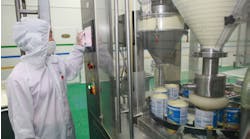Process Particle Size
The calculation shows that if the particle sizes are in the 10s of microns, they are likely to settle before reaching the spray nozzle. This problem will be aggravated if shear-induced agglomeration is occurring. The pipe work should be dismantled and inspected for signs of settling.The Coriolis meter should be replaced with another flow meter that has a straight flow path through that has less of a tendency to plug in the presence of solids. In fact the system would be more efficient if the piping could be shortened, with less elbows. If elbows have to be used, they should be long radius.If changing the pipe layout is feasible, a return line to the vessel should be installed. The slurry should be pumped at a flow rate such that the system operates in the turbulent regime. As a minimum, the flow should be tripled to 90 gallons per hour; this would raise the Reynolds number to 3,600. A bleed of 30 gallons per hour should be taken to feed the spray nozzle and 60 gallons per hour returned to the vessel, where the Reynolds number would be 2,400. This would prevent the problem of shear-induced coagulation and reduce the time available for the particles to settle. The line taking the bleed from the recirculation piping to the spray nozzle should be resized to ensure that it operates in the turbulent regime also.Finally, the spray and dryer system should have been designed for a certain droplet size contacting the corn flakes. If possible, samples of the spray should be collected to check that the droplet size is small enough.
Richard K. Grenville, Director of Mixing TechnologyPhiladelphia Mixing Solutions, Palmyra, Pa.MAKE MULTIPLE CHANGESThere are a number of possible improvements: • A mixing tank without baffles usually means a lot of vortexing and little real mixing or bottom-top turnover. Consider adding four vertical baffles 4–6-in. wide and 48-in. long, set at the tank bottom.• I assume the positive displacement pump is a gear pump that could pass clumps. A piston pump would likely have problems with check valve plugging and normally have pulsating flow, which would create more problems in metering and spraying. A filter or 100–200-mesh strainer in the line at the pump discharge should prevent clumps going to the dryer• Is there a reason for the 1½-in. size of the 190 to 200 ft of pipe? 30 gal/h (gph) or 0.5 gal/min (gpm) is a very low flow in a 1½-in. pipe. Velocity and pressure drop would suggest a ¼-in. line. (1.5 ft/sec and 4.33 psi dP).• A single spray nozzle is shown; this would make it difficult to control amount of spray over the width. The width of conveyor is not given, so no recommendation can be made on nozzle arrangement or type; use a flat fan type.• A batch lasts some 15 hours. Using a single tank means there must be time for complete dissolution of the aspartame. Also, I assume the aspartame dissolves in the oil; a slurry would very likely create problems in the 1½-in. pipe.
Art Krugler, engineerKrugler Engineering Group, Inc., Whittier, Calif.LOOK TO THE SOLIDSAs long as the oil and the aspartame are well mixed, I don’t think there will be much plugging in the meter or nozzle. Certainly, preventive maintenance and periodic inspection of the spray nozzle should tell you. The only other liquid issue is if there are pump pulsations evident in the spray pattern or flow measurement. Does the positive displacement pump or line have a pulsation dampener? If not, one should be installed. Monitor the spray pattern with a camera and look for universal wetting of flakes.In applications involving a solid such as the flakes, my first inclination is to see if there is excessive mounding or uneven distribution of the flakes on the belt. Mounds of flakes, wet on the outside, dry on the inside, would cause clumping. Using a rake as a dispersing comb upstream of the spray point could help. Here’s another thought: as the conveyor unloads the wetted flakes, is the belt adequately wiped and dried on its return to the flake deposit point? Adding a wiper, with a deposit and liquid catch pan, and a hot-air drying system downstream of it could prevent a damp belt. Without these, flakes will be prematurely wetted prior to the spay nozzle, leading to clumping.
Tom Brader, staff instrument engineer, Valero, St. Charles, La.IT’S NOT JUST THE MIXINGThis is one of those problems where everyone could be right. The Coriolis meter probably is plugged but not enough to affect the readings I would wager. The spray nozzle is likely plugged from the clumps of aspartame. If you take all of these symptoms they point to a mixing problem. Mixing in a small tank shouldn’t pose a problem provided the setup is correct, which this isn’t. Here’s a quick tally of what’s wrong with the mixing: • At a speed of 450 rpm, I estimate a draw of about 0.67 hp, which is more than the 0.62 that the ½-hp motor can provide.• The good news is that because the tank is unbaffled the power draw will actually be lower than it should be because once the liquid is swirling, there isn’t really any other mixing going on. It’s cheapest to change the orientation by a 10–13° offset than to install baffles. Test the orientation in a laboratory if possible.• A rule of thumb is >10 hp per 1,000 gallons for blending slurries. I calculate about 376 gallons at 80% level — that’s 3.76 hp. A better perspective would be to consider the solid as an “in-motion” suspension — Power = 0.55104×(D/T) -1.4698, where D/T is impeller diameter/tank diameter. Using this assumption, the agitator should draw 5.14 hp to ensure that all of the solids are lifted off the bottom; a fillet will exist until the solids dissolve. This step in the mixing should be done prior to using the aspartame/canola oil and not with this mixer.The mixing problem can be fixed easily by only using this tank for the holding tank after the aspartame is dissolved into the canola oil. Confirm the temperature and formula properties, if possible. An in-line mixer or shear mixer has been used in this service but I think that’s wrong. I would replace the marine impeller with a high flow one, which will reduce the power draw by the agitator: the N
p (power factor) for a marine impeller is 0.87 while N
p is only 0.30 for a typical high-efficiency impeller. Note that the equation for power draw is: HP = 0.0006566×(N
pN
3D
5SG), where N is speed in rpm; D is impeller diameter in inches, and SG is specific gravity based on water. Going with a larger high-efficiency impeller will increase shearing of the solid particles and the pumping rate of the agitator: Q = ND3N
q/231, where Q is in gpm. A 10.5-in. impeller at 450 rpm produces 1,736 gpm compared to 1,792 gpm for a typical 11.8-in. high-efficiency impeller, which is the largest impeller of this type. The D/T ratio increases significantly to 0.246.Solving the agitator problem takes you only part way home. There are a number of improvements that will make this a reliable process: 1) the Coriolis flow tubes should be in a vertical position, i.e., hoop down (forming an inverted U), so that the meter can drain properly — during the shutdown for the project, the tubes should be flushed and cleared; 2) install a pressure gauge and a globe valve to more easily control flow to the spray nozzles; and 3) add to the preparation phase the sifting of aspartame prior to its addition to the tank for dissolving.Another problem looking for a solution is spray nozzle control. It is very difficult to set the spray correctly, or adjust it, with a globe valve located at the pump and not at the spray nozzle. So, install a gauge and valve there to adjust the spray. A globe works best but a ball valve can be managed and is easier to clean and meet FDA standards. The spray must be adjusted to contact the cereal but not create a mess inside the dryer. One idea for improvement might be to add a camera at the side of the spray nozzle to witness the contact at the conveyor.
Dirk Willard, consultantWooster, OhioNOVEMBER’S PUZZLERWe’re planning to increase the capacity of a diesel hydrotreater unit by replacing part of the recycle hydrogen currently used with fresh hydrogen from an existing 1,200-psig system (see Figure 2). The header begins as an 18-in., schedule-80 pipe. The control valves are each fed from a line right off the header. Figure 2 shows what the header system looks like: the 1,600-ft line now handles a flow of 868 million standard cubic feet per day (MMSCFD) of hydrogen; the expansion will raise the total flow to 918 MMSCFD. One branch delivers 5 MMSCFD to isomerization. Another branch services a variety of hydrotreaters. It runs 2,500 ft and furnishes 200 MMSCFD to a hydrocracker, and then goes 3,100 ft where a common branch feeds two diesel hydrotreaters, which get 75 MMSCFD and 63 MMSCFD, respectively, and an ultra-low-sulfur diesel (ULSD) hydrotreater, which is fed 75 MMSCFD. After the diesel header, the line decreases in size to 12 in. and goes 2,700 ft to a kerosene hydrotreater fed 85 MMSCFD. It then continues 2,600 ft to a naphtha hydrotreater that gets 75 MMSCFD and to another header that delivers 140 MMSCFD to a gasoline hydrotreater and 150 MMSCFD to a fluid catalytic cracker (FCC) hydrotreater. The expansion will increase the hydrogen flow to the diesel hydrotreater 2 to 113 MMSCFD from 63; the % open for the control valve only will increase to 76% from 61%, so the project has been approved. The flows are all nominal-high values. A production engineer now is questioning the idea of increasing the fresh H2 output; he’s afraid it will put a strain on the system. What do you think?


